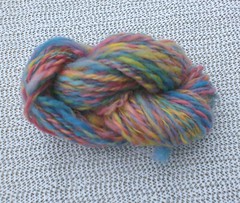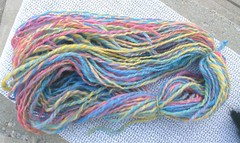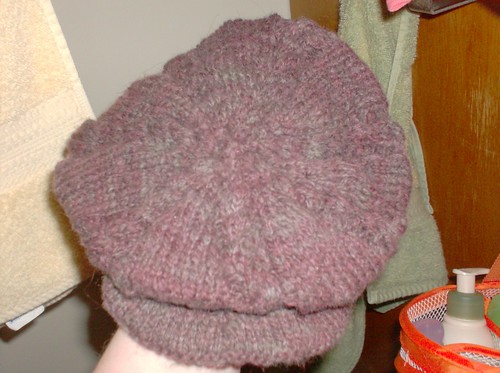This is the first part of a 2-part article about how to knit with handspun yarn.
If you are learning to spin, or are patronizing a spinner (for instance, myself or any of the number of talented handspinners on Etsy and elsewhere), you quickly find out that the yarn you make by hand is quite distinct from the yarn you buy at a shop. Knitting with handspun can pose some challenges if you're used to knitting exclusively with commercial yarn. Here's what you should know.
Handspun is unique. Being handmade, every skein of handspun is different. Most skeins are unique and in some cases completely unreplicable. For instance, I get my roving from a variety of different places, including small online shops and fiber festivals. I might pick up a few ounces of fiber, and never be able to locate the seller again.
Even different skeins from the same roving can appear different - for instance, these are two skeins in my shop that I spun from the same Corriedale roving, which I call "Party Time".


One is noticeably brighter in color than the other. This could be due to the method in which it was spun, dye bleeding during washing, or simply being spun from a part of the roving that was particularly bright. Either way, consider switching skeins every few rows, the same way you would with a hand-dyed yarn, to keep the colors consistent. Or, use handspun in conjunction with other yarns, in stripes or colorwork, to make the difference between the two skeins less jarring.
Weight and density. Handspun yarn is often noted for being denser than millspun yarn. That is, if you take two balls of yarn with the same amount of yardage and the same thickness, the handspun yarn will weigh more. That means that you will have less yardage from the same weight of yarn. If you're used to being able to get a pair of socks out of 100g (about 3.5 ounces) of yarn, for instance, you may want to get 4 ounces of handspun yarn.
In addition, handspun yarn is usually thick-and-thin. This can be done intentionally, for instance in slubby artyarns, but many times it's just a result of the spinning process. I still can't get my yarns completely consistent, though I can get close if I make an effort. Chances are, there will be thick spots and there will be thin spots in your handspun yarn. Luckily, things will even out a little bit when you're knitting with it, especially if you're knitting at a good firm gauge. Take a look at the first project I knit from my handspun yarn.

Ravelry page
It's a newsboy cap ("Headline News"), from the Stich n Bitch Nation book. When I spun up my yarn, I didn't think I'd be able to make anything with it. Now that it's been knit up into a hat, you can hardly tell the inconsistencies. If you inspect it closely, you can see thin spots and thick, slubby spots, but overall it's knit up into a lovely finished object.
Plying will even out the yarn somewhat also, which I'll be talking about in the second part of this article. Look for it in the next few days.
~Joy
Continue to Part two
A Fine Fleece: Knitting with Handspun Yarns

 The Grateful Crane Shawl
The Grateful Crane Shawl Elven Slippers
Elven Slippers Russell Square Mitts
Russell Square Mitts Russell Square Tam
Russell Square Tam iTouch Jumper
iTouch Jumper Twisty Wristband
Twisty Wristband Mawata Pulsewarmers
Mawata Pulsewarmers
Thanks for this post, very informative! I'm proud to say my first skein of handspun is on it's way as we speak from Australia:) I made a vow to start using handspuns in my work more and it's good to know there is a difference so I can know what to expect. Thanks!
ReplyDeletevery informative...
ReplyDeletei really don't have any idea about knitting..
but this post is really awesome...
i really like the 2nd skein...
jeremae here. thanks for the comment in my blog btw.. ^_^
Lots of useful information in your article. Thank you for sharing your knowledge! Its posted here on my crafts carnival: http://keikigifts.brighterplanet.org/tutorial/crafts-carnival-7
ReplyDelete